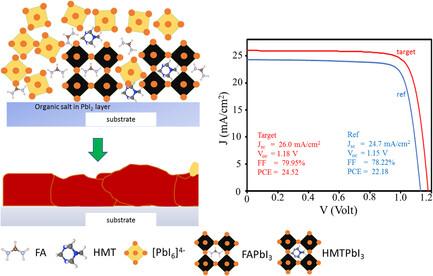Our official English website, www.x-mol.net, welcomes your
feedback! (Note: you will need to create a separate account there.)
Enhancing the Phase Crystallinity of Buried Layer Perovskites through Organic Salt Molecule-Assisted Crystal Growth
Solar RRL ( IF 6.0 ) Pub Date : 2024-07-23 , DOI: 10.1002/solr.202400380 Akrajas Ali Umar 1, 2 , Nim Bahadur Devkota 3 , Shijie Dai 3 , Waqar Ahmed 3, 4 , Xiaoguo Li 3 , Jiao Wang 3 , Anran Yu 3 , Yiqiang Zhan 3
Solar RRL ( IF 6.0 ) Pub Date : 2024-07-23 , DOI: 10.1002/solr.202400380 Akrajas Ali Umar 1, 2 , Nim Bahadur Devkota 3 , Shijie Dai 3 , Waqar Ahmed 3, 4 , Xiaoguo Li 3 , Jiao Wang 3 , Anran Yu 3 , Yiqiang Zhan 3
Affiliation

|
The performance and stability of perovskite solar cells rely crucially on the purity of their active perovskite phase. While the two-step method has emerged as a well-known technique for fabricating high-performance cells, it suffers from significant PbI2 phase impurities at the buried layer due to inefficient diffusion of cationic molecules into the preprepared PbI2 layer. Herein, a simple yet highly effective method is presented to boost phase purity within the buried layer by introducing formamidinium iodide (FAI) seed molecules into the underlying PbI2 layer. X-Ray diffraction analysis result reveals that this process significantly reduces the PbI2 phase and enhances the purity of the perovskite's phase. It is also observed that this technique can produce perovskite layer with a remarkably smooth surface structure and large interconnected crystal grains, forming a continuous layer. These characteristics are subjected to further enhancement when hexamethylenetetramine molecules are concurrently introduced with FAI into the PbI2 layer. Solar cells fabricated using this method, with an active area of 0.1 cm2, achieve a remarkable power conversion efficiency of up to 24.52% with Voc as high as 1.18 V, representing a substantial improvement over cells produced using the standard two-step method, which attains only 22.18% efficiency. With its simple yet impactful approach, the present method should find widespread adoption in the production of high-performance perovskite solar cells.
中文翻译:

通过有机盐分子辅助晶体生长提高埋层钙钛矿的相结晶度
钙钛矿太阳能电池的性能和稳定性在很大程度上取决于其活性钙钛矿相的纯度。虽然两步法已成为制造高性能电池的众所周知的技术,但由于阳离子分子向预先制备的PbI 2层中的扩散效率低下,其在埋层处存在显着的PbI 2相杂质。本文提出了一种简单而高效的方法,通过将碘化甲脒(FAI)种子分子引入下面的 PbI 2层来提高埋层内的相纯度。 X射线衍射分析结果表明,该过程显着减少了PbI 2相并提高了钙钛矿相的纯度。还观察到该技术可以产生具有非常光滑的表面结构和大的互连晶粒的钙钛矿层,形成连续的层。当六亚甲基四胺分子与FAI同时引入到PbI 2层中时,这些特性得到进一步增强。使用该方法制造的太阳能电池,有效面积为0.1 cm 2 ,功率转换效率高达24.52%, V oc高达1.18 V,比使用标准两步法生产的电池有显着改进,效率仅为 22.18%。凭借其简单而有效的方法,本方法应该在高性能钙钛矿太阳能电池的生产中得到广泛采用。
更新日期:2024-07-23
中文翻译:

通过有机盐分子辅助晶体生长提高埋层钙钛矿的相结晶度
钙钛矿太阳能电池的性能和稳定性在很大程度上取决于其活性钙钛矿相的纯度。虽然两步法已成为制造高性能电池的众所周知的技术,但由于阳离子分子向预先制备的PbI 2层中的扩散效率低下,其在埋层处存在显着的PbI 2相杂质。本文提出了一种简单而高效的方法,通过将碘化甲脒(FAI)种子分子引入下面的 PbI 2层来提高埋层内的相纯度。 X射线衍射分析结果表明,该过程显着减少了PbI 2相并提高了钙钛矿相的纯度。还观察到该技术可以产生具有非常光滑的表面结构和大的互连晶粒的钙钛矿层,形成连续的层。当六亚甲基四胺分子与FAI同时引入到PbI 2层中时,这些特性得到进一步增强。使用该方法制造的太阳能电池,有效面积为0.1 cm 2 ,功率转换效率高达24.52%, V oc高达1.18 V,比使用标准两步法生产的电池有显着改进,效率仅为 22.18%。凭借其简单而有效的方法,本方法应该在高性能钙钛矿太阳能电池的生产中得到广泛采用。

















































 京公网安备 11010802027423号
京公网安备 11010802027423号